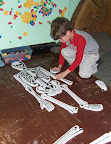Children learn “All About Me” while using science tools
By Peggy Ashbrook
Posted on 2010-09-11
Beginning a new school year often means teachers have new students to get to know, and vice versa. Returning students have report cards or portfolios from the previous year. Children who are attending the school for the first time don’t have those records so information from their family is especially important. But there is much to learn! Starting the year with a look at ourselves, “All About Me” (a favorite theme of young children and adults!), is one way to learn about the child’s life—family, favorite books and foods, and places to visit, gain an initial appreciation of their personality and skills, and introduce the beginnings of scientific inquiry.
 Explorations about the senses of smell and touch and charting the “favorites” teach that each of us have different preferences, and can lead into a discussion of why we record and reflect on data. Cover small containers of freshly cut lemons, onion, cinnamon stick and coffee beans to smell. Surprisingly to me, onion was the favorite for a few of my children.
Explorations about the senses of smell and touch and charting the “favorites” teach that each of us have different preferences, and can lead into a discussion of why we record and reflect on data. Cover small containers of freshly cut lemons, onion, cinnamon stick and coffee beans to smell. Surprisingly to me, onion was the favorite for a few of my children.
Feely Boxes with a small opening for a hand reduce our reliance on our sense of sight. Using science tools for measuring, such as a bathroom scale to see “how hard you will be to lift” and a length of hand prints or a measuring tape to see how long your arm is, help children become familiar with tools that remain available all year for other explorations.
 Children or teachers can list the descriptive words they use as they look at their hands and hair with a magnifier, another tool they will use year-round, perhaps learning new words, or some in additional languages. Putting together a child-size flat foam puzzle of a human skeleton is often a group effort with much discussion about who gets to put on the head, the relative lengths of arm and leg bones, and who is taller, the skeleton or the child.
Children or teachers can list the descriptive words they use as they look at their hands and hair with a magnifier, another tool they will use year-round, perhaps learning new words, or some in additional languages. Putting together a child-size flat foam puzzle of a human skeleton is often a group effort with much discussion about who gets to put on the head, the relative lengths of arm and leg bones, and who is taller, the skeleton or the child.
Here are a two books for thinking about diversity in animal/human bodies:
Two Eyes, a Nose, and a Mouth by Roberta Grobel Intrater. 2000. Scholastic. A book of face photographs with rhyming text delighting in the variety in human faces feature by feature.
What do you do with a tail like this? by Steve Jenkins and Robin Page. 2003. Houghton Miffllin. Unique and interesting body parts and questions lead to finding out how animals’ body shapes and functions help them survive.
Two more books, for talking about how our bodies relate to who we are:
I Like Me! by Nancy Carlson. 1990. Puffin. What do we like about ourselves? Carlson’s pig knows her strengths and what she likes about herself.
I Like Myself! by Karen Beaumont, illustrated by David Catrow. 2004. Harcourt Children’s Books. Making silly faces, doing near impossible feats, and all while appreciating herself, a sweet child uncovers all the ways she likes herself.
I like the smell of chocolate.
Peggy
Disclaimer: The views expressed in this blog post are those of the author(s) and do not necessarily reflect the official position of the National Science Teaching Association (NSTA).


